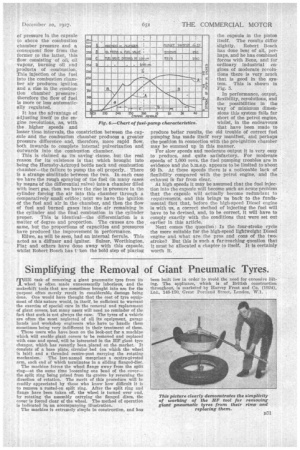Simplifying the Removal of Giant Pneumatic Tyres.
Page 49

If you've noticed an error in this article please click here to report it so we can fix it.
THE task of removing a giant pneumatic tyre from its wheel is often. made unnecessarily laborious, and the makeshift tools that are sometimes brought into use for the purpose often merely result in considerable damage being done. One would have thought that the cost of tyre equipment of this nature would, in itself, be sufficient to warrant the exercise of special care in the removal and replacement of giant covers, but many users will need no reminder of the fact that such is not always the case. The tyres of a vehicle are often the most neglected of all itS equipment, garage bands and workshop engineers who have to handle them Sometimes being very indifferent in their treatment of them.
Those users who have been on the look-out for a machine which will enable giant covers to be removed and replaced with ease and speed, -will be interested in the Er giant tyre changer, which has recently been, placed on the market. It consists of a base plate, circular bed (on which the wheel Is laid) and a threaded centre-post carrying the rotating mechanism. Tim last-named comprises a centre-pivoted arm, each end of which terminates in a sliding flanged-disc.
The machine forces the wheel flange away from the split ring—at the game time loosening one bead of the cover— the split ring being prised from its groove by reversing the direction of rotation. The merit of this procedure will be readily appreciated by those who know how difficult it is to remove a rusted-on split ring. After the split ring and flange have been taken off, the wheel is turned over end, by rotating the assembly earryins' the flanged discs, the cover is forced clear of the wheel. The method of operation is indicated in an accompanying illustration.
The machine is extremely simple in construction, and has
been built low in order to avoid the need for excessive lifting, The appliance, which is of British construction throughout, is marketed by Harvey Frost and Co. (1024), Ltd„ 148-150, Great Portland Street, London, 1N.1.




































































































